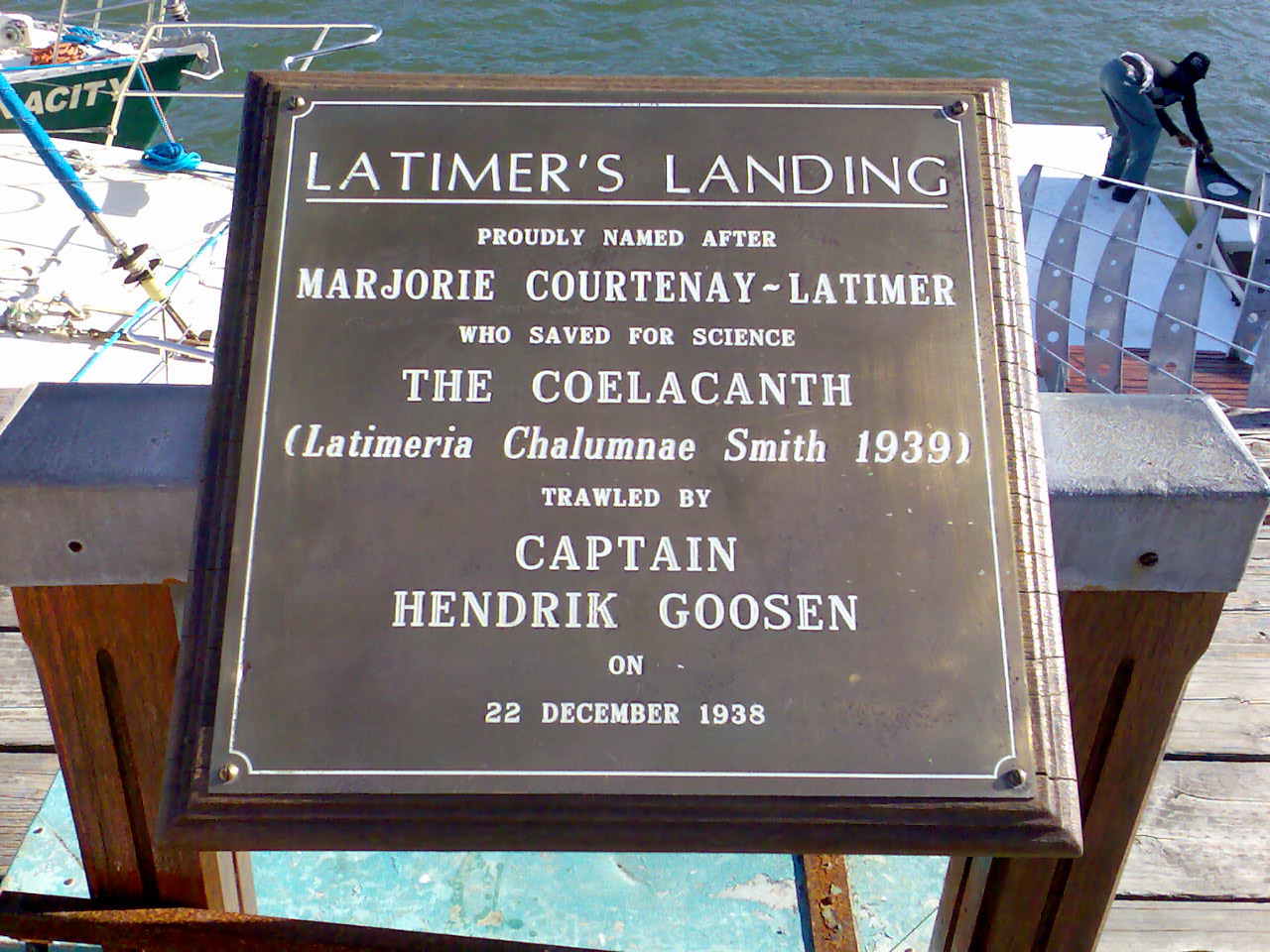1. Overview

Marjorie Eileen Doris Courtenay-Latimer (24 February 1907 - 17 May 2004) was a prominent South African museum official and naturalist. She gained international recognition in 1938 for her pivotal discovery of the coelacanth, a fish species previously believed to have been extinct for approximately 65 to 70 million years. Her finding profoundly reshaped scientific understanding of evolution and ancient marine life, establishing her as a significant figure and a pioneering woman in the field of natural history.
2. Life
Marjorie Courtenay-Latimer's life was marked by an early passion for nature and a career dedicated to scientific discovery, culminating in one of the 20th century's most remarkable zoological finds.
2.1. Childhood and Education
Marjorie Courtenay-Latimer was born prematurely by two months on 24 February 1907, in East London, South Africa. Her father served as a stationmaster for South African Railways. Throughout her childhood, she was often sickly, once nearly succumbing to a diphtheria infection. Despite her frail health, she developed an avid interest in naturalism from a young age and enjoyed outdoor activities. During visits to her grandmother on the coast, she was particularly fascinated by the lighthouse on Bird Island. At the age of eleven, she made a solemn vow to become an expert on birds.
After completing her schooling, Courtenay-Latimer pursued training to become a nurse in King William's Town. However, just before she finished her training, she learned of a job opening at the recently established East London Museum in East London, Eastern Cape. Although she had not received any formal training in natural history, her extensive knowledge of South African naturalistic subjects deeply impressed her interviewers. Consequently, she was hired at the age of 24 in August 1931.
2.2. Early Career
q=East London, South Africa|position=right
Courtenay-Latimer dedicated the remainder of her professional career to the East London Museum. During her initial years at the institution, she diligently worked on collecting various specimens for the museum's collections, including rocks, feathers, and shells. She actively communicated her desire to acquire unusual specimens to local fishermen, a practice that would eventually lead to her most celebrated discovery.
3. Discovery of the Coelacanth
Marjorie Courtenay-Latimer's discovery of the coelacanth was a monumental event that captivated the scientific world, challenging long-held beliefs about extinction and the continuity of life forms.
3.1. Discovery Process

On 22 December 1938, Courtenay-Latimer received a telephone call informing her of an unusual fish among the bycatch from the trawler Nerine, which had just returned to port under the command of Captain Hendrik Goosen. She immediately went to examine the catch and there, amidst the other fish, she discovered a truly striking specimen. She later described her initial encounter with the fish: "I picked away at the layers of slime to reveal the most beautiful fish I had ever seen... It was 5 ft long, a pale mauvy blue with faint flecks of whitish spots; it had an iridescent silver-blue-green sheen all over. It was covered in hard scales, and it had four limb-like fins and a strange puppy dog tail. It was such a beautiful fish-more like a big china ornament-but I didn't know what it was."
3.2. Preservation and Identification

Courtenay-Latimer and her assistant transported the fish to her museum in a taxi, but despite their efforts, they could not identify it using the available reference books. Eager to preserve the unique specimen, but lacking adequate facilities at the museum, she first attempted to take it to the town mortuary and then to a cold storage facility, both of which refused to store it. Facing the challenge of preservation, especially in the hot and humid South African summer, she eventually took the fish to Robert Center, a taxidermist she knew. Center helped her wrap the specimen in formalin-soaked newspaper and bedsheets to prepare it for identification.
She immediately attempted to contact her friend, J. L. B. Smith, a renowned ichthyologist at Rhodes University, for assistance with identification. Unfortunately, Smith was away on holidays, and her initial attempts to reach him went unanswered. By 27 December, with no response from Smith and the fish beginning to decay and ooze oil, Courtenay-Latimer reluctantly authorized Center to skin and gut the fish to prepare it for mounting.
Smith eventually made contact with Courtenay-Latimer some days later. Upon seeing the taxidermied specimen on 16 February 1939, he instantly recognized it as a coelacanth. He famously declared, "There was not a shadow of a doubt... It could have been one of those creatures of 200 million years ago come alive again." Smith subsequently gave the fish the scientific name Latimeria chalumnae, honoring Courtenay-Latimer and the Chalumna River where the fish was found. It would be another fourteen years before a second coelacanth specimen was discovered.
4. Personal Life and Later Activities
Beyond her scientific contributions, Marjorie Courtenay-Latimer's personal life reflected resilience and a continued dedication to the natural world even after her retirement.
4.1. Personal Life
Marjorie Courtenay-Latimer never married. This decision was influenced by a significant personal loss in her twenties, when the "love of her life" passed away.
4.2. Post-Retirement Activities and Writings
After a long and distinguished career at the East London Museum, Courtenay-Latimer retired. She initially moved to a farm located in Tsitsikamma, a region known for its natural beauty. During this period, she continued her engagement with natural history by authoring a book on flowers, titled The Flowering Plants of the Tsitsikama Forest and Coastal National Park, published in 1967. Following her time on the farm, she eventually returned to East London.
5. Publications
Marjorie Courtenay-Latimer authored several notable publications during her career, primarily focusing on natural history subjects.
- Gray's Beaked Whale, Mesoplodon Grayi. Annals of the Cape Provincial Museums Vol.3 1963.
- The Flowering Plants of the Tsitsikama Forest and Coastal National Park. National Parks Board, South Africa 1967.
- [https://files.afu.se/Downloads/?dir=Magazines%2FUnited%20States%2FCryptozoology%20%28ISC%29/Reminiscences of the Discovery of the Coelacanth, Latimeria Chalumnae Smith: Based on Notes from a Diary Kept at the Time. Cryptozoology Vol.8 1989.]
6. Significance and Evaluation
Marjorie Courtenay-Latimer's discovery of the coelacanth had a profound and lasting impact on scientific understanding, and her legacy extends to her role as an inspiring figure for women in science.
6.1. Impact on Science
The discovery of the coelacanth by Marjorie Courtenay-Latimer was one of the most significant zoological finds of the 20th century. The coelacanth, often referred to as a "living fossil", belongs to a lineage of fish that appeared on Earth approximately 375 million years ago. Before her discovery, it was widely believed that this entire group had gone extinct around 65 to 70 million years ago, coinciding with the extinction of the dinosaurs. Her finding provided irrefutable evidence that these ancient fish still existed, fundamentally challenging previous assumptions about extinction events and the continuity of life forms over geological timescales. It forced scientists to revise their understanding of evolutionary pathways and the survival of ancient marine life, highlighting the vast unknowns that still exist in the deep oceans.
6.2. Status as a Female Scientist
Marjorie Courtenay-Latimer's achievements are particularly noteworthy given the context of the early 20th century, a period when the scientific community was largely dominated by men. Despite lacking formal academic training in ichthyology, her keen observational skills, dedication, and perseverance led to a discovery that reshaped scientific thought. Her resilience in the face of challenges, including difficulties in preserving the specimen and initially contacting experts, underscores her pioneering spirit. Courtenay-Latimer's story serves as an enduring inspiration for women pursuing careers in science, demonstrating that passion, meticulousness, and determination can lead to groundbreaking discoveries, thereby promoting greater social equity and representation in scientific fields.